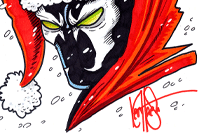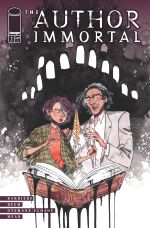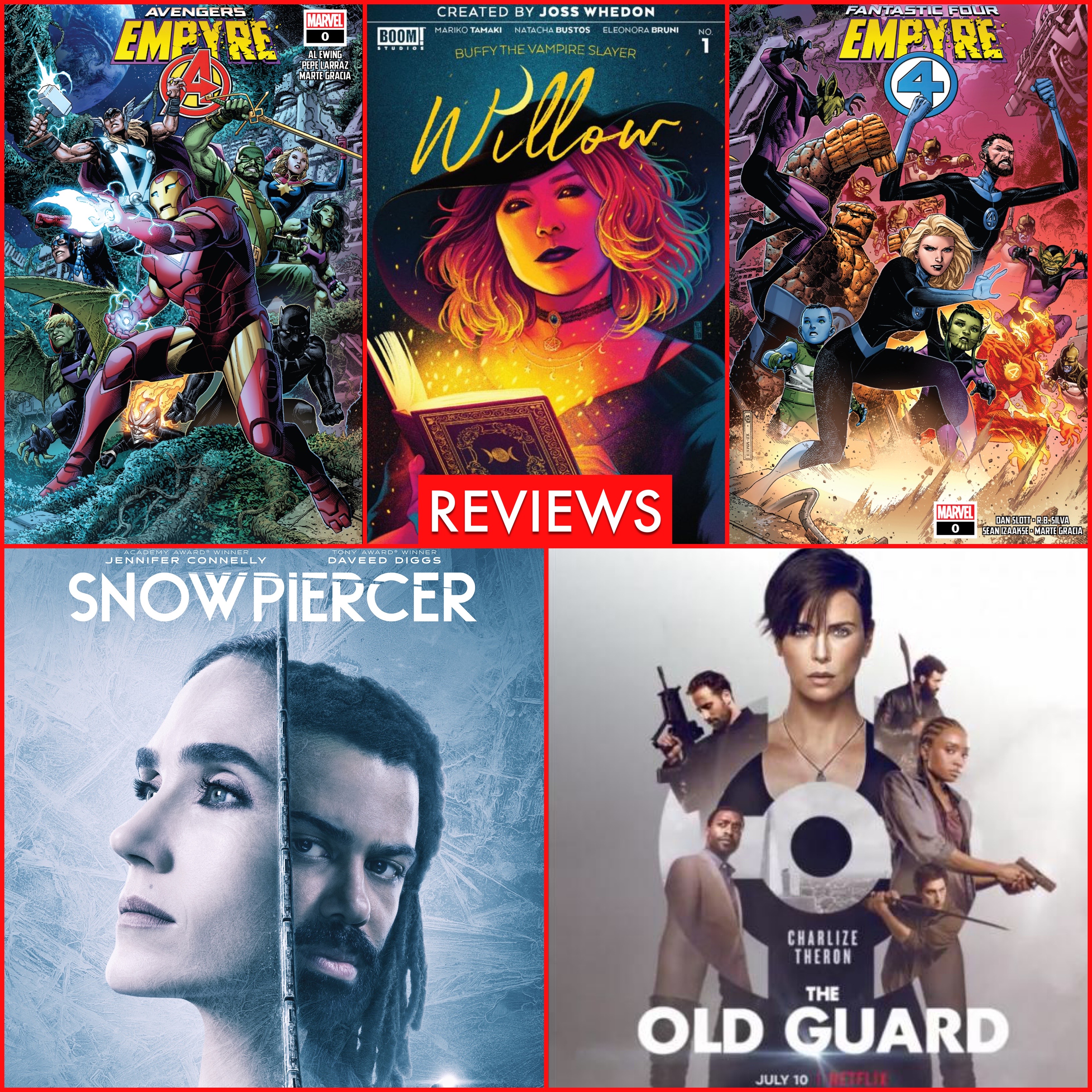TOM MORGAN
 SEND THIS TO A FRIEND! SEND THIS TO A FRIEND!
DF Interview: Tom Morgan and his magical trip from coloring his parents’ walls to Disney’s land By Byron Brewer Tom Morgan’s life has been one full of change, challenge and imagination. You might even call him an “imagineer”, but that title is already taken elsewhere in enchanted kingdoms on either coast of America. No, Morgan lives in a world of art that took him from early crayola work to the House of Ideas and then onward to the House of Mouse. The comic book artist-turned-animator talked to DF about his life and a wonderful world of color he is still building. Dynamic Forces: Tom, let’s start at the beginning when boy meets pencil. Tell readers about your love of art and how it brought you to comics and the House of Ideas, Marvel. Tom Morgan: Well, I suppose I’ve been drawing since I could hold crayons and mark up any nearby walls. This, of course, was frowned upon and so my parents gladly supplied paper to capture my wildly explosive colorful creations. Reems of hot rod doodles ensued. I’ve always been observant of motion and color, even as a child, so it’s not a mystery that I eventually found my way into animation, a job encompassing both. But secondhand comic books were always around me and this gave me an appreciation of colorful pictures that were hand drawn. I always knew somebody drew the comics, because if I could draw, then there had to be other people who could draw as well, right? That’s when I had the brilliant idea that was what I was going to do—I would draw comics! After all, I loved to read comics and I loved to draw, it seemed like a natural fit. So, I drew comics. For myself. This all probably started around third grade. Some stories starring existing comic book characters and some stories starring my own made up characters. This was tremendously great fun and I took it very seriously. I was a very studious third grader, at least when it came to cartooning! I tried to dissect the art of drawing for comics and eventually stumbled upon the approach used by the professionals, that a comic book was created in stages. Writing, penciling, lettering, inking and coloring. Looking at my very first page of original art created by a professional was mind blowing and eye opening to me. I studied the ink line weights. I held the page up to the light and absorbed the difference between pen and brush and my world grew. In high school, I started writing and drawing small 5-page black and white stories printed in my local comic shop’s newsletter. I was paid in free comics, which I thought was fantastic! I met a writer friend through the shop and we created more comics and a batch of samples to send off to professional publishing companies. We both left our Chicago area homes and headed to New York to get busy creating comics for the major publishing companies. That was the plan. But I didn’t have a job, or a place to live or very much money. Little matter, I was sure I would start drawing comics as soon as I got there. Didn’t happen. Not right away, anyway. After a couple of months of cheap living, practicing and submitting and receiving rejection letters, I landed a job drawing comics for an independent comics publisher, Spectrum Comics, based out of Connecticut, which was where I was living at the time. With several issues published by Spectrum, I started attending local comic conventions. At one very small local convention, attended by maybe a handful of people, I met then-Marvel Comics editor Mike Carlin, who looked at my printed books and sketchbooks and invited me up to Marvel for a quick tour. That tour resulted in my being assigned a Dazzler story (issue #37). I turned in the penciled pages and was given a second story as an inventory story (never printed). The most FORTUNATE event from getting this particular job was that I drew ugly women and The Dazzler is supposed to be super-gorgeous. Mike Carlin had the absolutely brilliant idea of introducing me to an artist who could help me draw better-looking women, and so he marched me right down to the office at Marvel of John Romita Sr. My heart skipped a beat and my hands sweated. I was an enormous fan of John’s work and this was like meeting royalty for me. John was so tremendously accommodating, he closed his door and gave me instruction on how to draw pretty girls for 45 minutes straight! Six months later, I started working for John in the Marvel Bullpen as one of his Romita’s Raiders. During the next couple of years, while still working for John and then subsequently taking over the Art Corrections Department as Managing Art Director, I started drawing various issues for Marvel. I left the staff job to go freelance when I received my first regular assignment: Captain America. DF: What was your favorite project for Marvel as a comic book artist, one of which you are most proud, and why? Tom Morgan: My favorite project would have to be when I drew and inked Iron Man. He’s always been my favorite character. However, I am very proud to have designed the U.S. Agent when I was drawing Captain America. Also, designing and drawing Punisher 2099 was a huge thrill for me. DF: How did you get into storyboarding? Tom Morgan: When the comics industry imploded in the late 1990s I was offered a job designing characters for Stan Lee Media. This meant I would have to move from the East Coast to the West Coast. And work directly with Stan Lee himself. Well, that was worth the relocation itself. I had lots of closed door one-on-one discussions with Stan. I loved that guy! I did design characters there initially and was asked to storyboard on several web-based animation series. I was a comics storyteller and with some great assistance from established storyboard artists and directors I quickly learned the differences to boarding for animation. DF: Having done coming book art, what are some of the challenges – some mentally, some procedurally, I am sure – in doing storyboards? Can you compare and contrast for readers? Tom Morgan: When drawing comics, the rendering is for a print media. The storytelling should be clear and characters should display a range of emotion and body language in very few drawings. You almost have to combine multiple actions in a single comics panel because you have so few pages to tell a story. You need to think in terms of form and dramatic lighting and dynamic posing. You have to compose your panels to show a variety of camera angles and perspective, choosing those that best provide information and keep the story moving forward and the reader interested. And the drawings have to be finished and print ready. By contrast, drawing storyboards for animation or live action (which I have also done) requires many of the same principles of clarity in storytelling, but there is also the added need to think like a cinematographer and a director. In comics, you can change the size and shape of a panel to suit the needs of the story, but in boarding for television or film the screen size remains constant. There is a whole different set of rules to know when presenting a story in a moving medium. You need to know cutting, pacing, lenses and performance. The drawings don’t need to be as tight as comics rendering, as you are generally giving a blueprint for animators to work from, determining shot size, angle and character performance, spread out over a sequence of frames. You need to be more of an actor when drawing storyboards. And you need to be much more of a team player when drawing storyboards. Most comics artists tend to work alone, drawing or inking and then turning in the pages when finished. In animation, there is a lot more back and forth with directors, writers, designers, production associates and producers. You also have to think funny. Many times I visualize and add gags that are not in the script. Sometimes it’s a performance tweak and others it’s adding a whole new bit of comedy or action that pluses the story. Many times it’s about reading between the lines of a script. DF: How did your taking the mantle of Storyboard Artist come about? Tom Morgan: I was asked to storyboard on various series at Stan Lee Media. With the exception of a few people there who had worked previously as storyboard artists and directors, most of the artists hired came straight from comics. Most of what I drew was instinctive and based on my comics experience telling stories and from watching a lot of old movies. I really learned on the job while drawing storyboards and am so fortunate to have met and learned from some of the best pros in the field. DF: Talk about some of the properties/projects you have worked on during your years at DNA Productions and Omation Studio. Tom Morgan: At DNA, an animation studio based in Texas, I worked as a lead storyboard artist on the theatrical feature film The Ant Bully, distributed by Warner Brothers. This was only supposed to be a three-month job, getting a rough pass of the film together. I ended up working on the film for three years! I moved from California to Texas and ate a whole lot of BBQ! One of the benefits of working on a film as opposed to a television show is the amount of production time. We were able to build scenes, tear them apart and re-build them to a polished finish. The time spent working on that film was really a masterclass in learning storyboarding for me. I worked with veteran storytellers from feature films who educated me in the art of storyboarding. I also drew an episode of Jimmy Neutron: Boy Genius which aired on Nickelodeon. The guys at DNA were the creators of that movie and then the subsequent show. At Omation, I continued storyboarding first on a television show called Back at the Barnyard and then I moved BACK to California when Omation started a spinoff series of Jimmy Neutron called Planet Sheen. I did design work for the show and single-handedly drew every single shot that sold the show to Nickelodeon, a fifteen-minute pitch episode that was heavily used in the actual on air pilot episode. I drew storyboards for Sheen and eventually directed multiple episodes. DF: Although I have always seen a storyboard artist as filling a director’s shoes, in a manner of speaking, what new duties came with being an actual animation director? Tom Morgan: I directed multiple episodes of Planet Sheen at Omation. I had previously directed web animation episodes for Stan Lee Media a couple of years prior. While at SLM, I was also a producer, overseeing the daily production of multiple series. The director’s job at both of these productions had me overseeing teams of creators, from finessing scripts and giving input on designs of characters and backgrounds to guiding artists handling the drawing chores on episodes during handouts of the scripts. Also working with various coordinators keeping track of storyboards and assets as they are produced and implemented into the production pipeline. Many times I would draw corrections or change scenes after the storyboard had been turned in by the initial artist to clarify action or add comedy bits. Often I would sit in recording sessions and give voice direction to actors if the voice director was not available. One of my favorite directing duties was to sit with an editor and finesse the cutting together of an episode, tweaking frame counts to sweeten a comedy bit or sometimes rearranging scenes for greater impact or clarity. Also, playing with sound effects is a lot of fun! At this stage, a show starts to really feel alive, combining sound and motion with picture. I would also give notes on compositions, sound effects and music spotting and visual tweaks needed after various passes of animation, from rough blocking to finished animation. DF: Tell us about how you came to the Promised Land of Walt Disney Animation Studios in 2010 – what did that feel like? – and what properties you have worked on. Tom Morgan: In my case, it was a matter of who I was already working with. I had been drawing storyboards for a different production at a different company, working with a director, who had previously worked at Walt Disney Television Animation. He returned to Disney as a producer and asked me to draw storyboards for him there as well. I had been trying to crack that Disney nut for a decade after I stopped drawing comics and I finally was invited in with welcome, open arms! That was like a lifelong dream come true, much like joining the staff at Marvel! I have worked on various productions here at WDTVA including drawing storyboards for Mickey Mouse Clubhouse, Jake and the Neverland Pirates, Elena of Avalor and Mickey and the Roadster Racers. Also a handful of Chip and Dale and Mickey Mouse shorts. DF: What are you currently working on for Disney now? Any spoilers are fine (LOL). Tom Morgan: Mickey Mouse Mixed-Up Adventures. It’s an offshoot of Mickey and the Roadster Racers, but a bit crazier with wilder stories and an invitation to go bananas visually! That suits me perfectly. I love that! Dynamic Forces would like to thank Tom Morgan for taking time out of his busy schedule to answer our questions.
NEW! 1. 09/23/2025 - FRANK BARBIERE2. 09/16/2025 - RODNEY BARNES 3. 09/10/2025 - ZACK KAPLAN 4. 08/26/2025 - JOE PRUETT 5. 08/20/2025 - CHRISTIAN WARD Show All |








